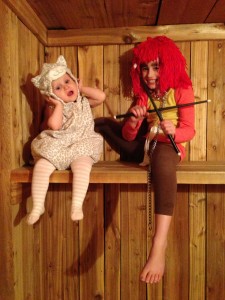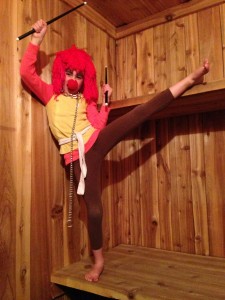“If human beings had genuine courage, they’d wear their costumes every day of the year, not just on Halloween.”
~ Doug Coupland
The Psychology of Halloween has long been debated because of the terror associated with the holiday. Halloween has indeed a twofold agenda: freighting and terrorizing, as well as, playful and fantasy.
 THE FEARS ASSOCIATED WITH HALLOWEEN
THE FEARS ASSOCIATED WITH HALLOWEEN
Halloween injects the greatest fears associated with humanity into our lives. From Hollywood to Bollywood, you can view films associated with Halloween. Halloween grabs hold of the internal frailty of our minds. It perpetuates the unknown, the undetermined, and the mysteries sometimes involved with life.
Be cautious to moderate your child’s intake of “scary” movies and “scary” novels. Children can find it difficult to differentiate between fantasy and reality. As parents, we should monitor every single source of conditioning that influence our children.
While Halloween is known for instilling fear, it does not have to feed into our fears. It can be a holiday that proves a source of fun, fantasy, and imagination. For children, it is important to help develop a healthy imagination filled with creativity and adventure.
“Dr. Gene Beresin, Director of Child and Adolescent Psychiatry Training, Massachusetts General … Kids love Halloween, and it should not be denied… It is celebrated in schools, at parties, and is looked forward to all year. To deny this, would be a major deprivation, and could even reinforce that something so horrible is happening, that we need to change our ‘business as usual.’ …Halloween is viewed as a party, as a time to dress up, and most importantly, a way for kids to allay fears of ghosts, goblins and supernatural events. It is much akin to playing. We would not want our younger kids to stop playing, since they work out most of their fears through this means.” (ABCNews, 2012, Online)
HALLOWEEN, A HOLIDAY OF MERE PRETEND
Disney’s “Doc Mc Stuffins’” Halloween episode “Boo-Hoo To You” explains to young children that Halloween is merely for enjoyment, fun and is all just pretend. The episode helps younger children to recognize that Halloween and characters associated with Halloween are make believe. Not unlike the Disney-PIXAR movie “Monster Inc.”, Doc Mc Stuffin’s Halloween episode helps children to quash the fears commonly associated with monsters and freighting customs.
Doc Mc Stuffin’s is on a quest to help her friend Sebastian the Ghost overcome his fear associated with Halloween. Doc Mc Stuffin’s helps her friend understand that many of the symbols associated with Halloween are for fun and are not to fear. For example, Doc Mc Stuffin’s has a toy witch hanging from her ceiling named Hazel. Sebastian is freighted of this witch and many other objects. Doc Mc Stuffin’s explains to Sebastian “that’s Hazel, she’s pretending to be scary, but she’s so nice.” Through this episode Sebastian learns a lesson that fear is only what you make of it. In the end, Sebastian understands that Halloween and “everything (associated with it) is just pretend, I think I’m ready to get down to spooky business.”
Ironically, Monster’s Inc. has a twist on the fear associated with monsters, goblins, and the unknown. Whereas, we frequently think of the monsters freighting us, in Monster’s Inc. the monsters have an inbred fear of children. The monster’s treat the children as untouchables fearing being contaminated by the children. It is only once a child enters the city of monsters, Monstropolis, that children and monsters are forced to extinguish their fears.
FEAR
Teach your children to always ask themselves the following questions:
- Are your fears reasonable?
- Are your fears tangible?
- Are your fears genuine?
- Do you have a need to fear?
- Can your fear be overcome?
- Why fear something that is out of your control?
Fear does not have to ruin an individual’s life. While “Kids seem to love monsters and other scary things,” (Watson, 2008, Online) they do not have to be subject to live in a state of fear to have a pleasurable experience. Furthermore, fear does not have to be the premise of Halloween party or festivities. Especially for younger children, Halloween can be a time of dressing up as their favorite cartoon character, heros, family members, religious figureheads, or other significant players in their life.
While fear is often associated with safety and caution, they are not the same. To be cautious or safe is to follow one’s wisdom. Fear is a negative player in life and it is ultimately limiting. Fear can be stifling, halting a person’s desire to try new things. As a society, we often associate fear with the fuel that ignites our risk taking behaviors, but fear is a limiter not a promoter. If we learn to overcome our fears recognizing that we are in charge of our lives, then we too can adventure out challenging the greatest of life’s obstacles.
It is always important to recognize that fear is a detriment, whereas a healthy and balanced life can be lived successfully without the need of fear. In 1932, President Franklin D. Roosevelt stated in his first inaugural address, that the “only thing we have to fear is fear itself.” What a powerful message, a message of hope, invigoration, and confidence. As parents, we can live a life of confidence, wisdom, and security. As children, we can learn the tools necessary to live a life beyond the clutches of fear.
It is never unwise to have plans for safe and positive living. Teach your children to always communicate when, what, and where they plan on trick-or-treating. It is important that your children trick-or-treat with friends, family, and others known unto you. When your children are playing dress-up, teach them that the mask or costume is only a make believe item, and not something they should avoid.
Protecting Your Children on Halloween
- Never allow your children to trick-or-treat alone.
- “Go up to the door with young kids, or stand in the street.” (Watson, 2008, Online)
- “Let the kids take the lead because they have to be in control to make this work.” (Watson, 2008, Online)
- Discuss fears that may be induced while trick-or-treating, or any other Halloween celebrations.
- You can empower young children to conquer their fears by allowing them to tackle the “unspoken” fears.
- Never put a child down because of their fears.
- Children should be taught to be wise in every aspect of life.
- Teach your children to always trick-or-treat in neighborhoods and areas familiar to you and your family.
- Communicate daily with your child before and following the Halloween festivities.
- Be certain that your child is aware that they can discuss any and all matters with you.
- Do not berate, scold or criticize your child when they are sharing their heart and conscience.
- If an issue prevails, request support from your child’s school, teachers, principals, advisors, school counselors, and school psychologists.
- If capable, hire a professional (counselor, psychotherapist, psychologist) to help you and your child to engage about the issues troubling them.
- Remind your child daily of their goodness, worth, and personal value.
In the end, always remember to make the most of a moment. Teach your children to develop a healthy imagination. Children only have one shot at their childhood, make the most of it.
Author: Dr. Asa Don Brown, Ph.D., C.C.C.
REFERENCES
ABCNews (2012) Halloween questions and answers. Retrieved October 28, 2012, from http://abcnews.go.com/Health/story?id=117146&page=1#.UI7Ydo68W1w
Watson, M. (2008) Brandeis psychologist: How kids can enjoy Halloween without getting scared. Retrieved October 29, 2012, from http://www.youtube.com/watch?v=zGssiiZOJJ8
*The views expressed by our authors are personal opinions and do not necessarily reflect the views of the CCPA
